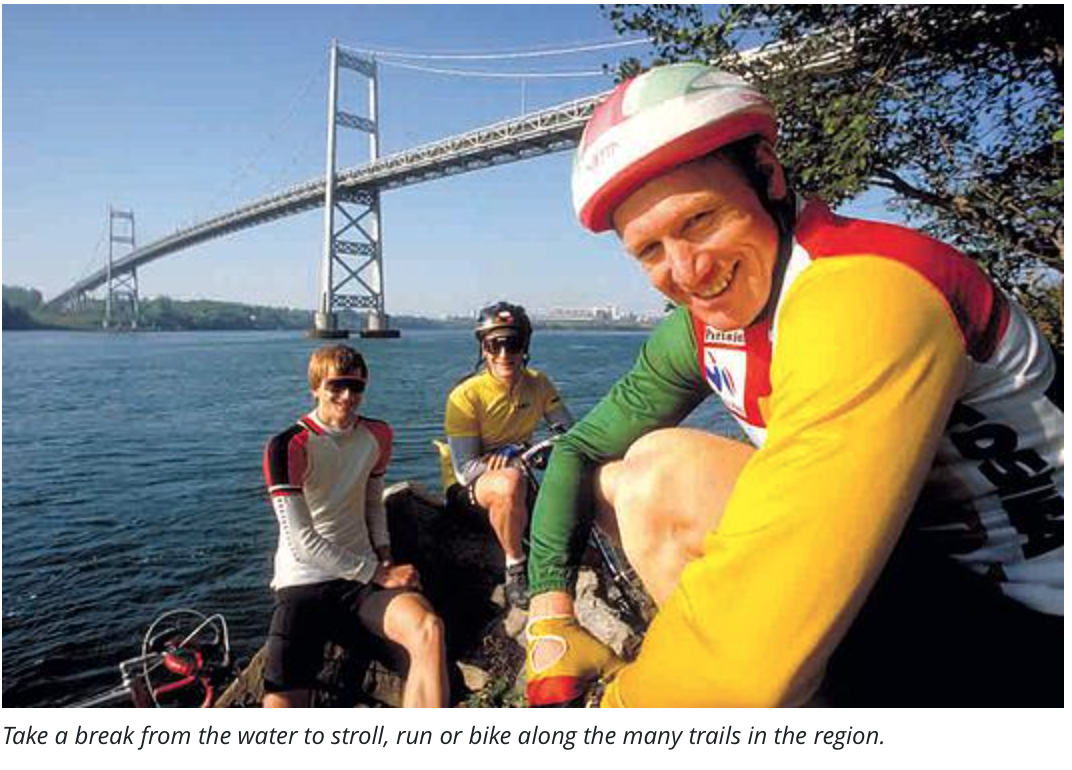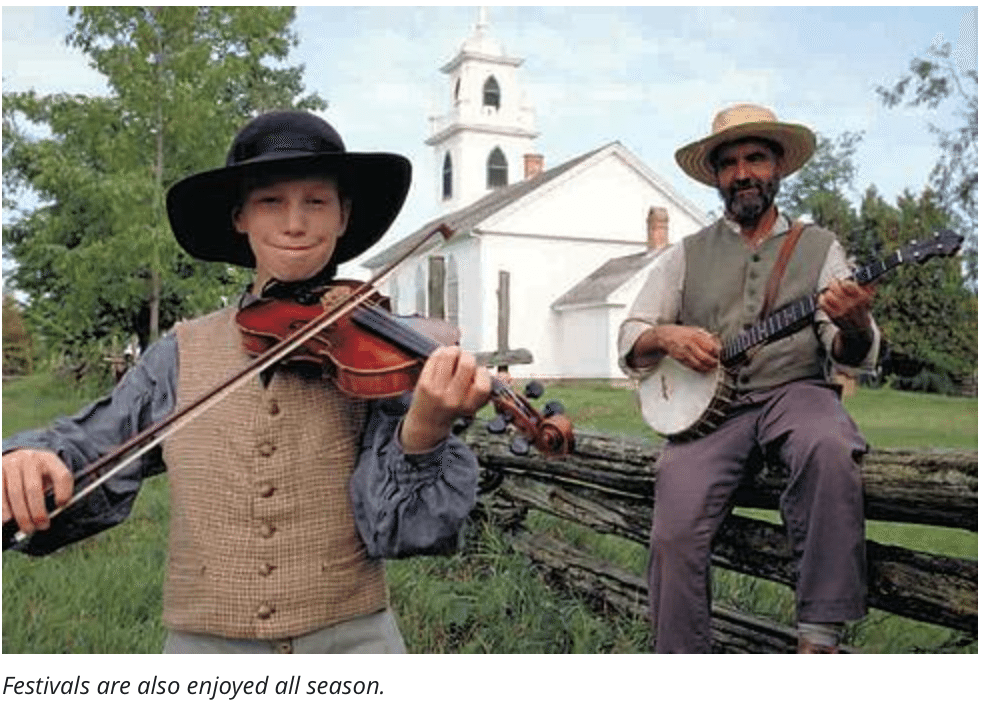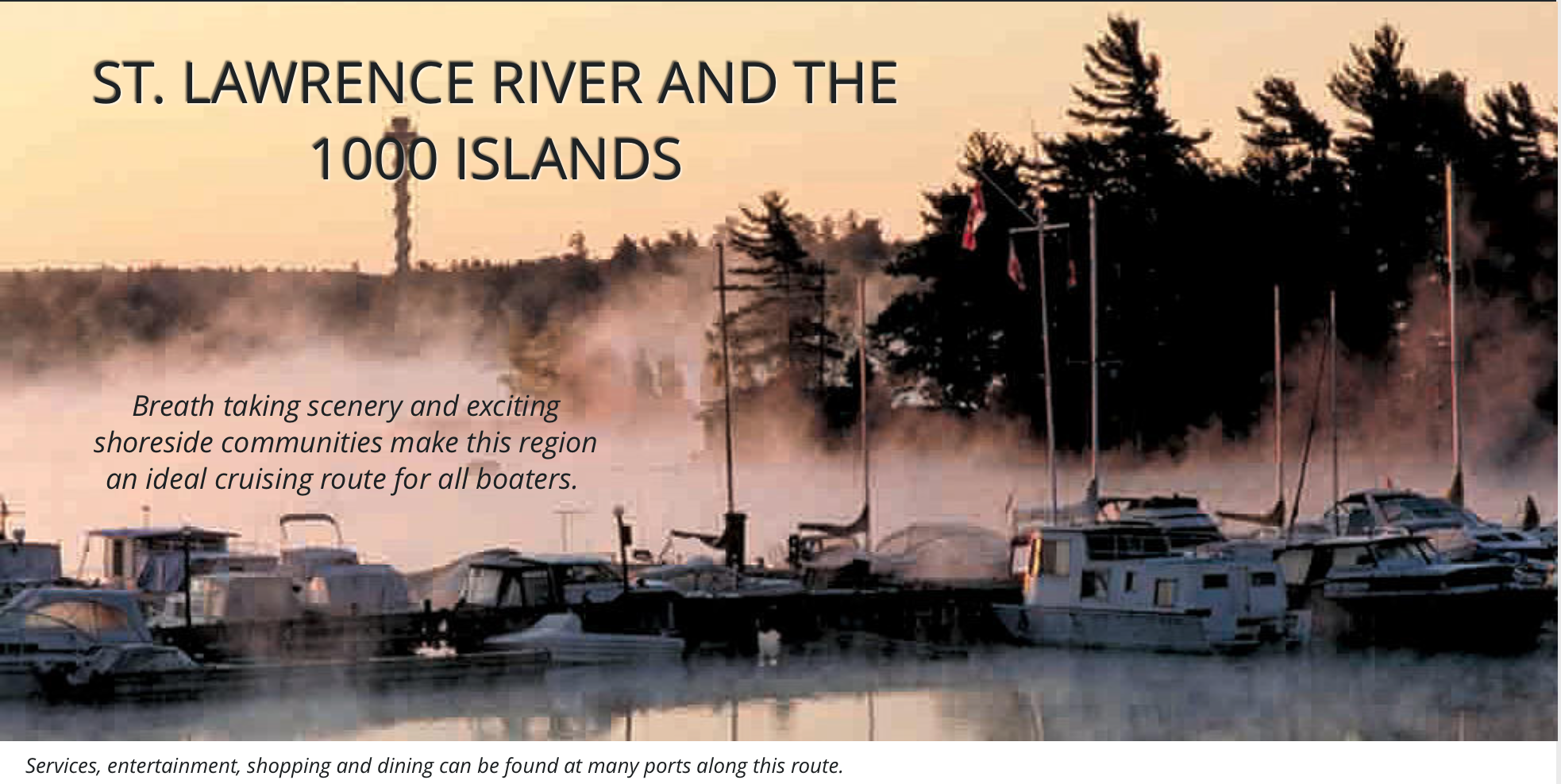The St. Lawrence River and 1000 Islands region draws thousands of boaters each season because it’s unlike any other waterway in Canada. Scattered islands, isolated anchorages, wide open cruising and historic, shore-side communities all await those who plot a course here.
Situated at the eastern end of Lake Ontario, Kingston is the largest centre in this area with plenty to do. Vast in history, the former capital’s insightful past can be observed in a number of the local museums. Kingston is also known as the fresh water sailing capital of Canada. Steady winds and open water as well as the proximity of large harbours attract many sailing events throughout the season.

But if it is services, entertainment, shopping or dining you’re interested in – all can be easily accessed from the several marinas including two in Collins Bay (located just west of the city), Portsmouth Olympic Harbour, (located between the downtown shopping core and the bustling suburban malls), or Confederation Basin (located in the heart of downtown).
Don’t miss the 1000 Islands and Thousand Islands National Park with full-season or overnight passes available for the public docks. The park consists of all or parts of 21 islands, approximately 90 islets (scattered between Kingston and Brockville), and a mainland base at Mallorytown Landing. Interpretation boards and hiking trails await curious boaters who visit here. It’s recommended to get to your destination early, especially during weekends throughout the summer, as the limited slips fill quickly.
Staying in Canadian waters when you leave Kingston you can choose the Canadian Middle Channel which avoids boat traffic close to marinas and the communities along the route.
The most scenic route after leaving Kingston however, is along the Bateau Channel. It follows the north shore close to marinas and communities and is better protected from the prevailing south west winds. On the south side of this channel is Howe Island. Be sure to watch out for the two cable ferries and keep in mind the cables can still be close to the surface after the ferries have passed by. At the eastern end of Howe Island, the channel turns sharply to port toward Gananoque.
An historic town that was prominent during the War of 1812, Gananoque is considered the Gateway to the Canadian 1000 Islands – it’s also a must-stop for transient boaters. At the municipal marina (located at the waterfront) you can dock for up to three hours to check out the area’s downtown district that has services, amenities, restaurants and of course, a series of shops. There is one other full service marina as well that is accessible up the Gananoque River. Taller boats will not be able to fit under the bridge adjacent to the Gananoque Inn.
The journey continues east from Gananoque where the inside channel meets with the Canadian Middle Channel at the Gananoque Narrows. For the more adventurous (with up-to-date charts), you can avoid the Middle Channel and explore the winding, unmarked passage along the Canadian shoreline. It’s scenic and offers a true sense of the region’s natural beauty. Or, play it safe and continue along the Middle Channel where you’ll be able to access a series of resorts and marinas dotting the north shore.
While the 1000 Islands Bridge and the Skydeck Tower on Hill Island are upstream, just before the bridge are two marked passages to the north. You can either stay in the middle channel or head north toward the village of Ivy Lea, which is home to a handful of marinas. Just before Ivy Lea, in Champagne Bay, are a couple of marinas that offer transient docking and some services including pump out and a restaurant. In Ivy Lea there are two marinas that offer service (but have no transient dockage) as well as an excellent restaurant with docking and a spectacular view of the area.
Just beyond the 1000 Islands Bridge is the village of Rockport. Here, marinas offer transient docking, service and fuel while the restaurants and tourist centres are ideal places to take a break from the water. For a change of pace, after Rockport, try following the Small Craft Route between Tar Island and Grenadier Island, which is closer to the north shore and leads past Mallorytown Landing where you will find the headquarters of the Thousand Islands National Park. Transient docking is available and be sure to check out some of the historical displays. There is also a play area for children and hiking trails.
You can also follow the 
Another large community in this region is Brockville or, as it is often referred to, the City of the 1000 Islands. In addition to excellent restaurants, shopping, exciting nightlife, a handful of marinas (with transient docking), there are several summer festivals.
While this entire region is full of history, history buffs will particularly enjoy Prescott with historic museums and Fort Wellington. Transient docking as well as several services, are available at the two local marinas. Immediately after Prescott is the Johnstown Bridge and just below, on the west side, is a local restaurant and marina with gas and pump out facilities. Repairs are also available here.
Next is Iroquois where you’ll encounter the first St. Lawrence Seaway Lock. There are special tie-up areas for recreational boats and special instructions for using the locks. You can download locking details and a handbook from the St. Lawrence Seaway web site. If you’re not comfortable with locks, there is a route through the control dam, one upstream passage and one downstream passage if you do not draw more than 8.5 feet. Sailboats cannot use these bypasses and Iroquois is the only lock that provides this recreational boat bypass.
There’s a local marina here, accessed through the entrance to the former canal west of the lock, offering gas, diesel and pump out facilities. As you continue on, watch for the marina that services Upper Canada Village and then the route to the next two locks. Before you get to these locks you can head to the Canadian shore to visit Long Sault, where there’s a marina with full services, gas, diesel, pump out facilities and a restaurant.
Just past Long Sault is the basin for the Moses Saunders Dam. Water flows swiftly through this area, which also makes it a popular fishing area. The Eisenhower and Snell Locks continue your journey to Cornwall.
From the locks, proceed past Cornwall Island and then turn to port to access the municipal marina. It has gas, diesel and pump out facilities and transient docks but no repair facilities. At Cornwall, you can shop at malls and specialty shops or dine at well established restaurants. Services and attractions are only a short walk. The journey from Cornwall to the Quebec border and Montreal takes you along a well-defined channel with several smaller communities and marinas along the way.
– Mark King
Be sure to check out these sites for more information about the
St. Lawrence River and 1000 Islands
Thousand Island National Park Kingston Gananoque Brockville Prescott South Dundas South Glengarry Cornwall Thousand Islands Area
Keyword : 10 best BOATING trips, Alberta BOATING, BC BOATING, Best boating trips, best BOATING vacations, Best marinas, Boating, boating adventures, BOATING advice, BOATING destinations, BOATING facilities, BOATING for beginners, boating in Canada, BOATING in New Brunswick, Boating in Nova Scotia, Boating in PEI, Boating in Quebec, BOATING in Saskatchewan, boating lifestyle, Boating Lifestyle Magazine, BOATING marinas, BOATING Marinas in Alberta, BOATING Marinas in BC, BOATING marinas in Canada, BOATING marinas in Manitoba, BOATING marinas in New Brunswick, BOATING Marinas in Newfoundland, BOATING marinas in Nova Scotia, BOATING marinas in Ontario, BOATING Marinas in PEI, BOATING Marinas in Quebec, BOATING marinas in Saskatchewan, BOATING Marinas near me, boating ontario, BOATING Power Boating advice, BOATING Power Boating tips, BOATING rentals, BOATING road trips, boating tips, BOATING Touring, BOATING travel, BOATING travel tips, boating trip, BOATING trip planning, BOATING trips, BOATING USA, boating vacation, BOATING vacations, Docks, Expert tips for BOATING trips, go boating, how to drive a boat, how to plan a BOATING trip, how to tow a boat trailer, how to use a BOAT, Let’s Go BOATING Canada, Manitoba BOATING, Marinas, Maritime boating destinations, ontario boating, plan a BOATING trip, power boating, Power Boating destinations, waterfront travel, where to boat, where to go boating 10 best BOATING trips, Alberta BOATING, BC BOATING, Best boating trips, best BOATING vacations, Best marinas, Boating, boating adventures, BOATING advice, BOATING destinations, BOATING facilities, BOATING for beginners, boating in Canada, BOATING in New Brunswick, Boating in Nova Scotia, Boating in PEI, Boating in Quebec, BOATING in Saskatchewan, boating lifestyle, Boating Lifestyle Magazine, BOATING marinas, BOATING Marinas in Alberta, BOATING Marinas in BC, BOATING marinas in Canada, BOATING marinas in Manitoba, BOATING marinas in New Brunswick, BOATING Marinas in Newfoundland, BOATING marinas in Nova Scotia, BOATING marinas in Ontario, BOATING Marinas in PEI, BOATING Marinas in Quebec, BOATING marinas in Saskatchewan, BOATING Marinas near me, boating ontario, BOATING Power Boating advice, BOATING Power Boating tips, BOATING rentals, BOATING road trips, boating tips, BOATING Touring, BOATING travel, BOATING travel tips, boating trip, BOATING trip planning, BOATING trips, BOATING USA, boating vacation, BOATING vacations, Docks, Expert tips for BOATING trips, go boating, how to drive a boat, how to plan a BOATING trip, how to tow a boat trailer, how to use a BOAT, Let’s Go BOATING Canada, Manitoba BOATING, Marinas, Maritime boating destinations, ontario boating, plan a BOATING trip, power boating, Power Boating destinations, waterfront travel, where to boat, where to go boating
